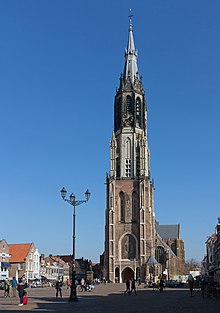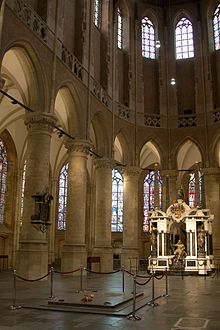

| Nieuwe Kerk | |
|---|---|

Nieuwe Kerk, Delft
| |
| Location | |
| Location | Delft, Netherlands |
| Geographic coordinates | 52°00′44″N 4°21′39″E / 52.0123°N 4.3609°E / 52.0123; 4.3609 |
| Architecture | |
| Type | Church tower |
| Style | Gothic |
| Groundbreaking | 1396 |
| Completed | 1496 |
| Height (max) | 108.75 m (356.79 ft) |
| Designated as NHL | Dutch rijksmonument #11872 |
The Nieuwe Kerk (Dutch pronunciation: [ˈniʋə ˈkɛr(ə)k]; English: New Church) is a Protestant church in the city of Delft in the Netherlands. The building is located on Delft Market Square (Markt), opposite to the City Hall (Dutch: Stadhuis). In 1584, William the Silent was entombed here in a mausoleum designed by Hendrick and Pieter de Keyser. Since then members of the House of Orange-Nassau have been entombed in the royal crypt. The latest are Queen Juliana and her husband Prince Bernhard in 2004. The private royal family crypt is not open to the public. The church tower, with the most recent recreation of the spire which was designed by Pierre Cuypers and completed in 1872,[1] is the second highest in the Netherlands, after the DomtoreninUtrecht.

The New Church, formerly the church of St. Ursula (14th century), is the burial place of the princes of Orange.[2] The church is remarkable for its fine tower and chime of bells, and contains the splendid allegorical monument of William the Silent, crafted by Hendrik de Keyser and his son Pieter about the year 1621, and the tomb of Hugo Grotius, born in Delft in 1583, whose statue, erected in 1886, stands in the marketplace outside the church.[2] Grotius' wife, Maria van Reigersberch, who had helped him escape in 1621 from his imprisonment at Loevestein Castle hidden in a book chest,[3][4] is also buried with her husband.[5] The tower of the church was built 1396-1496 by Jacob van der Borch, who also built the Dom in Utrecht during the years 1444-1475.[6] The monument for Hugo de Groot was made in 1781.[6] The mechanical clock has 18 bells by Francois Hemony from 1659 and 30 modern bells.[6] In the church tower there is a bell from 1662 by Francois Hemony with a diameter of 104 centimeters.[6] In the tower there are also bells no longer in use, including 13 from 1659 by Francois Hemony, 3 from 1678 by Pieter Hemony, 3 from 1750 from Joris de Mery, and 1 from Gillett and Johnston from 1929.[6]
The Kerk appears in the golden Age painting by Carel Fabritius, A View of Delft.[7] In 1586, Flemish scientist Simon Stevin used the church's tower to conduct an experiment on gravitational forces.[8]
Views of Delft and the Nieuwe Kerk
In September 2021, archaeologists announced that the remains of around 200 people had been discovered during the expansion of the royal burial chamber at Nieuwe Kerk.[9][10][11]




Eleven people are buried in the old vault:[12][13]
35 people are buried in the new vault:[12][13]
William III, Prince of Orange, is not buried in the royal crypt. He is buried in Westminster Abbey, due to his position as King of England at the time of his death.
{{cite book}}: |last= has generic name (help)CS1 maint: numeric names: authors list (link)
| International |
|
|---|---|
| National |
|
| Geographic |
|